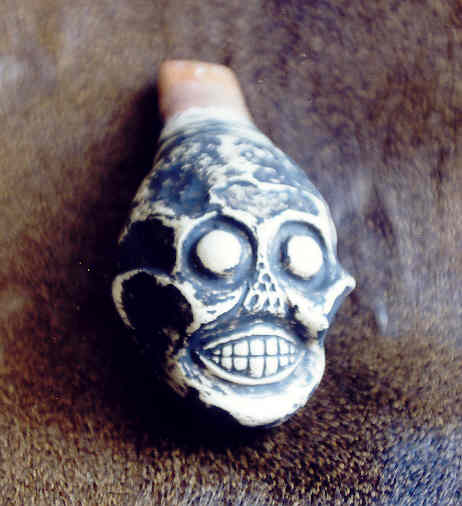
Aerophones of the death
Roberto Velázquez Cabrera
Virtual Research Institute Tlapitzcalzin
First version, April 30, 2003. Last version September 13, 2011.
A new related paper on the "Death whistle" was presented in the Special Sessions on Acoustics of Ancient Sound Instruments of the 2nd Pan-American and Iberian Meeting on Acoustics. Cancú, México, 15-19 November 2010. 160th ASA meeting - 7o Congress FIA - 17o Congress IMA.
The aerophones of the dead are mexican chaos/noise generators decorated with a cranium in the exterior of their resonating chamber. Initially, they were analized by some mexican researchers like Jose Luis Franco1 and Guillermo Contreras2, but their references are very difficult to get like the old sonorous subjects of their studies (stored in museums and collections). However, their available organological-acoustical information is limited to some photos, drawings and possible ancient general uses and very short and general descriptions. The decoration suggest that those noisy aerophones were used in ceremonies or rites related with the death and they had been called "death whistles", that are members of the family of "aerophones of double diaphragm". They can produce complex non musical sounds with variations in pitch and timber, depending of the way of their excitation and the configuration of the mouth cavity.
The sounding mechanism of the noise generators can have several internal designs and may be played outside and inside the mouth of the performer, which means that the sounding mechanism and the resonating chamber can be made inside the aerophone or to be formed inside the mouth. The "wind whistle" (with a the sounding mechanism shown in the firt row, seconf from the left, of the of previous photo) is played outside the mouth and it is well known, made and/or played by several mexican musicians, but their best makers are Mario and Gregorio Cortes from Texcoco.
They can be made in several shapes, designs and sizes of clay.
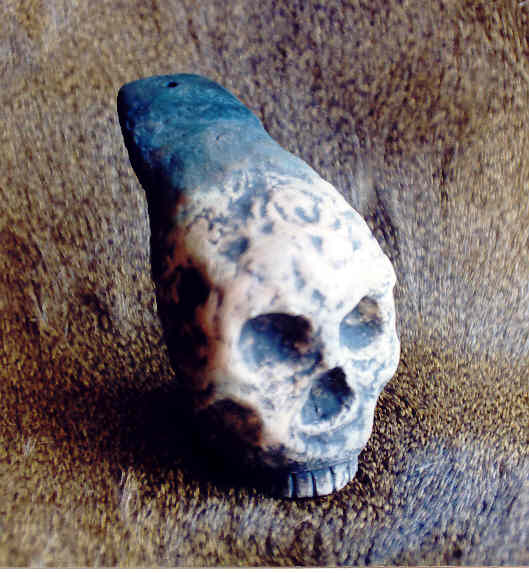
Experimental model inspired in a beautiful Totonacan sculpture.
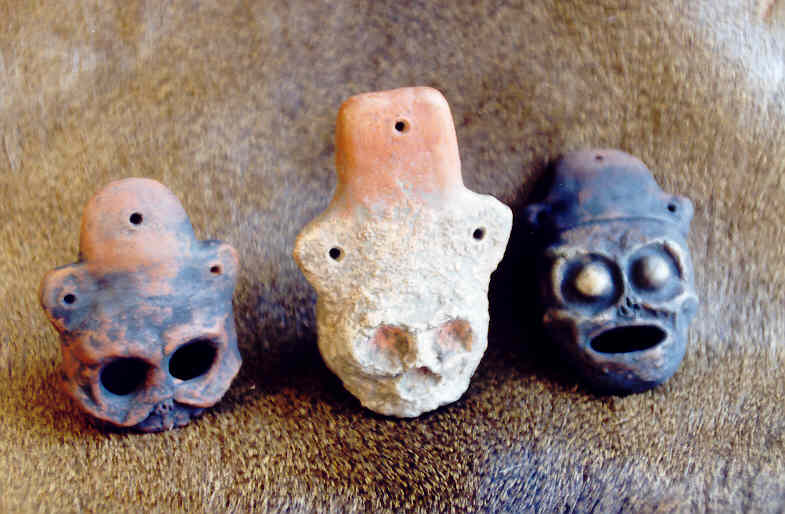
Noisy aerophones in several shapes.
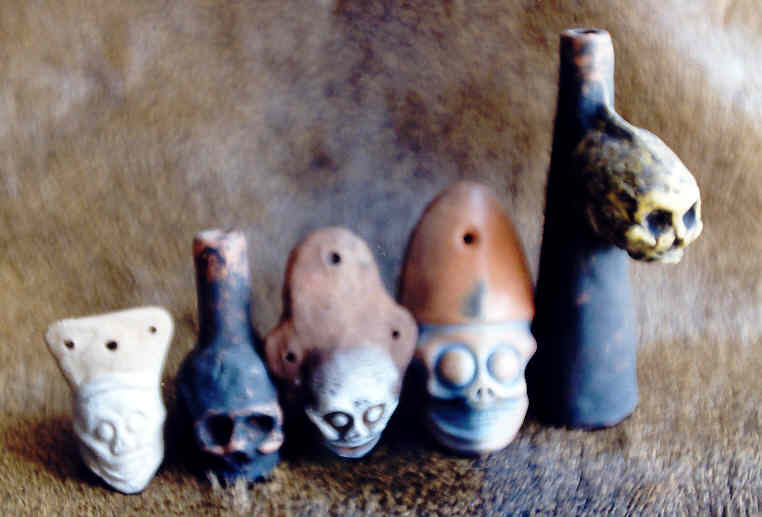
Noisy aeriphones in several designs, shapes and sizes.
The sounds can seem from the underworld. They are not musical sounds, but some noise generator with a large resonator (globular or tubular) can produce one or several peaks or crests, which may generate reedy whistling, like ancient animals howls or shrieks. This is the sound of a death's sing . It is possible to show visually the frequency components using spectrograms.
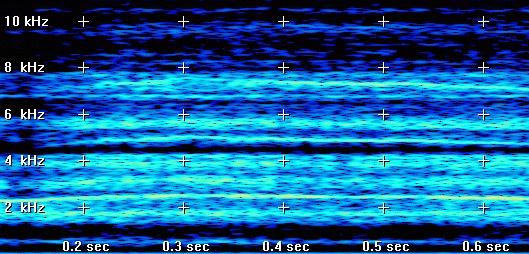
Spectrogram of the noisy whistling signal.
Those are the sounds of other noisy aerophones: a little aerophone with the face painted in white (the first at the left in the previus photo) and the noise of the wind (the second). In this cases of noisy signals the concept of fundamental (frequency), F0 or pitch is not clear, because several similar crests can be generated. The acoustic power of these noisy aerophones can be strong (0.25-0.8 Watts), and their perceived power is notable, because they have several crests and many frequency components in a wide band, many of them in the range of maximun human hearing sensivity (1-5KHz).
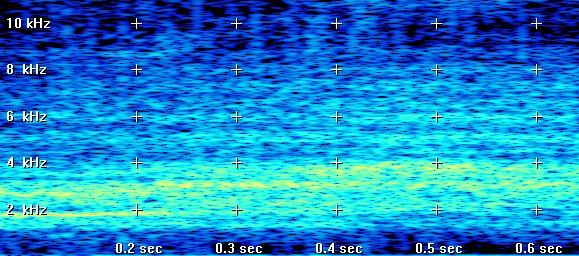
Spectrogram of the first previous sound with several peaks.
Some musicians can change the generated sounds enlarging the resonating chamber with the hands at the exit hole, but the acoustical possibilities of all the "aerophones of diaphragm" are not known and played.
The aerophones of the dead are very good to be used in shamanic rites and ancient "dramas" or performances. Their best and most impressive sounds are produced when the aerophones are played in a big set at the same time, because they generate complex phantom sounds or beats, but their effects in the health is unknown, as the exact ancient use of those extraordinary noisy aerophones. The acoustical possibilities of "bucal or mouth aerophones" can be increased when the acoustic possibilities of the coupled vocal tract are used as it happens with several simple ancient aerophnes. In this case, if the blowing is simple the sound is complex, but if the input blowing is complex the output sound is more complex.
The extraordinary noise generators can be usefull to dance and to roar like the devil, as it was shown in a short paper "Aerophone of the devil".
The oldest and simplest noisy aerophones of this type were made (in bone and stone) and used since the prehistoric time and in the beginning of several mexican cultures like those of the West and the Gulf Coast of Mexico and other designs were used up to the conquest in several cultures. Some of them were used several decades ago in some rural areas of Mexico, like one made of metal, which emigrates to Turkey. Other, in soft stone, emigrated to several zones of Europe like Spain.
The Mexican Noise Generator were presented and played in the First Sessions on Acoustics of Ancient Sonorous Instruments. and some members of this family of noisy aerophones were presented in other international meetings of acousticians like the olmecan gamitadera. and olmecan aerophone of black stone
Other references.
1. Franco, José-Luis, "Musical Instruments from Central Veracruz in Classic Times", Ancient Art of Veracruz, Exhibition Catalog of the Los Angeles County Museum of Narural History, 1971. The mexican engineer Franco was the first serious researcher of the "aerophones of diaphragm", but very few of his papers are known.
2. Contreras-Arias, Juan-Guillermo. "Atlas Cultural de México. Música." INAH. Grupo Editorial Planeta. ISBN 968-406-121-8. 1988. It is the best book with a general description of the "aerophones of diaphragm" and the "death whistles", but it is out of print.





